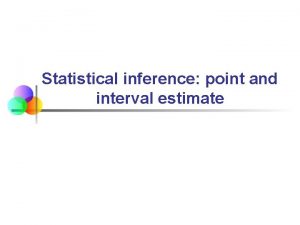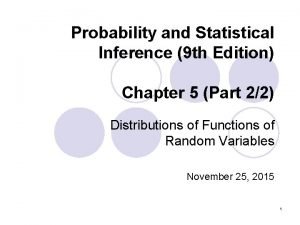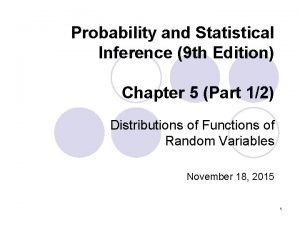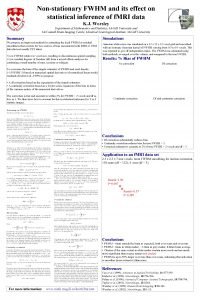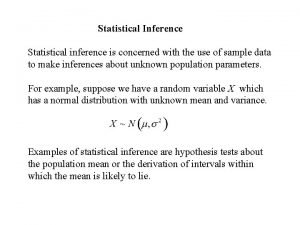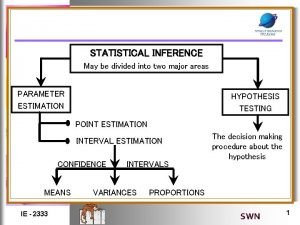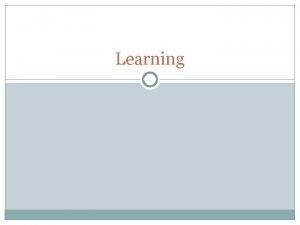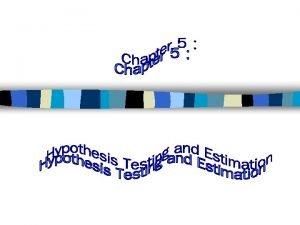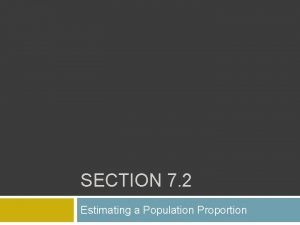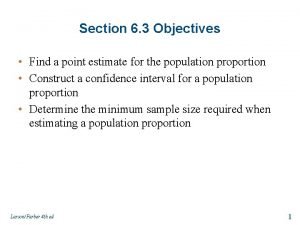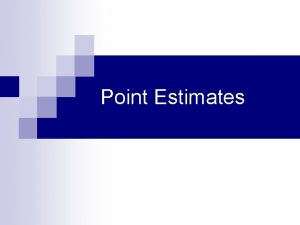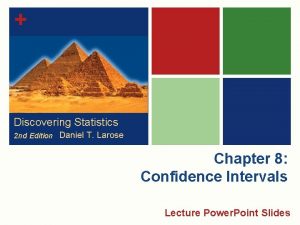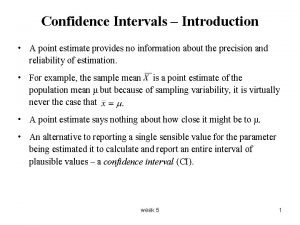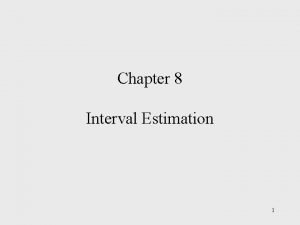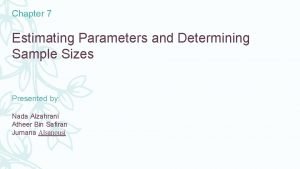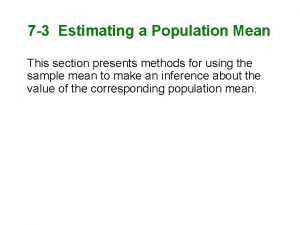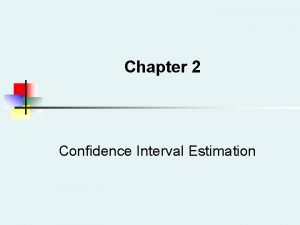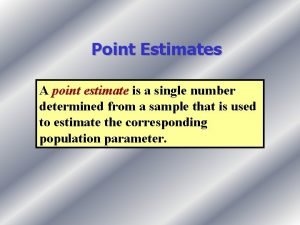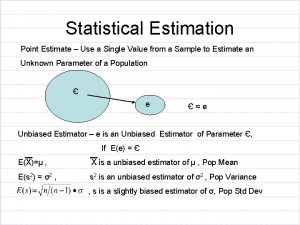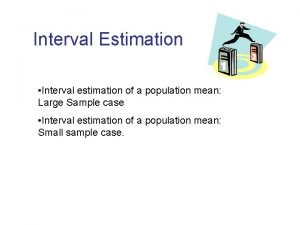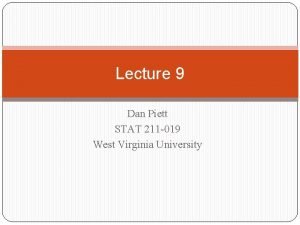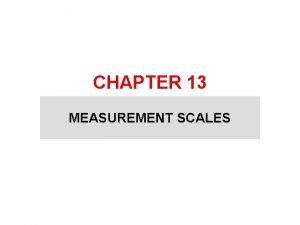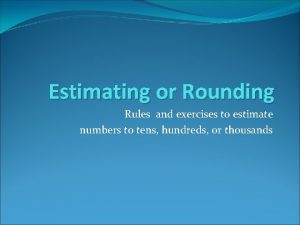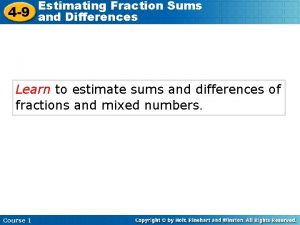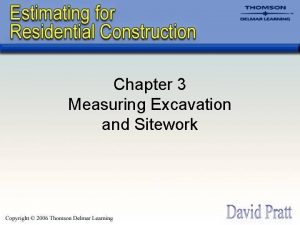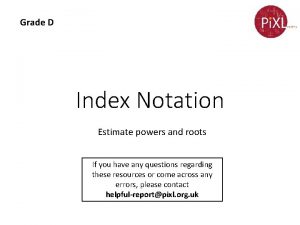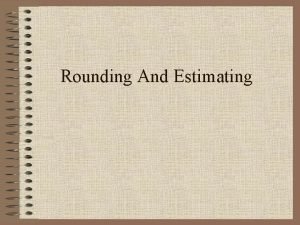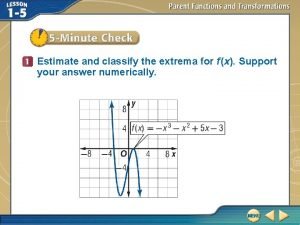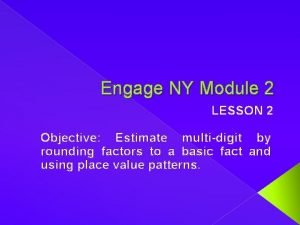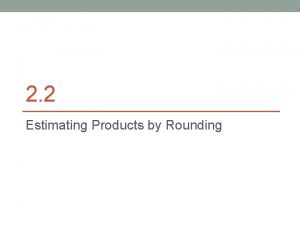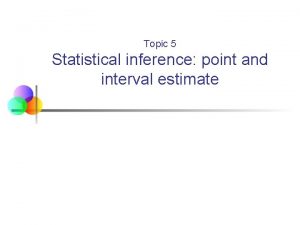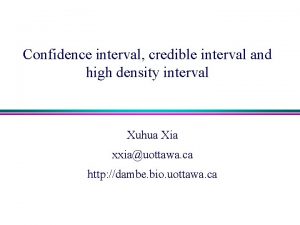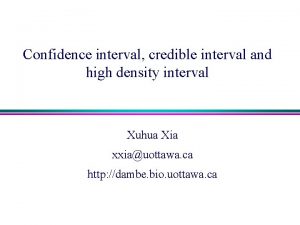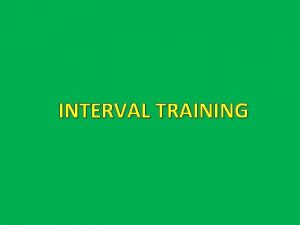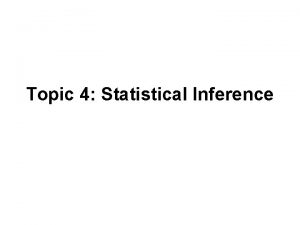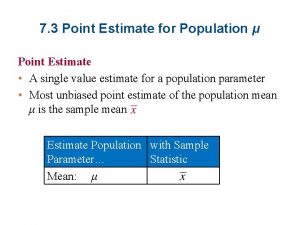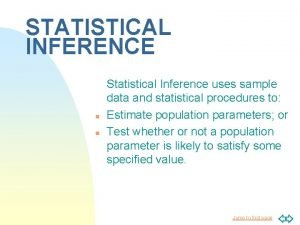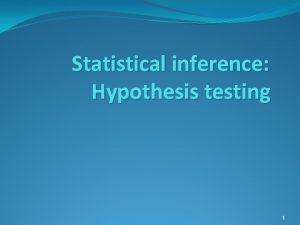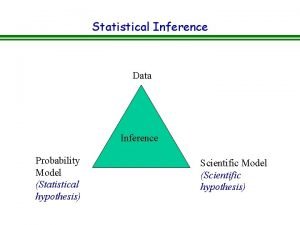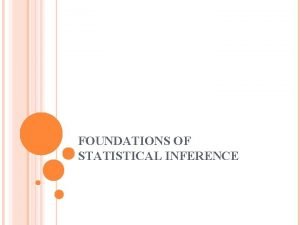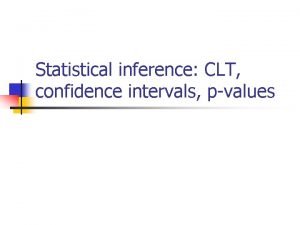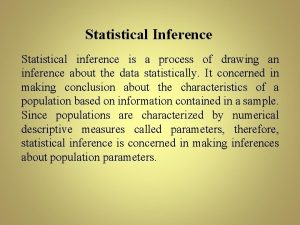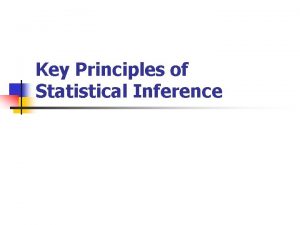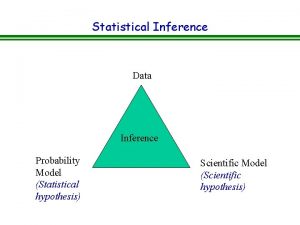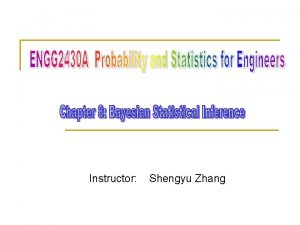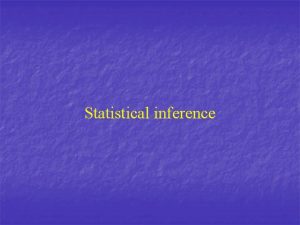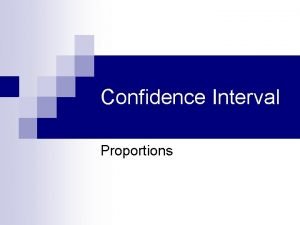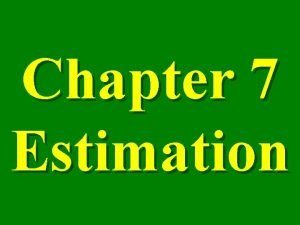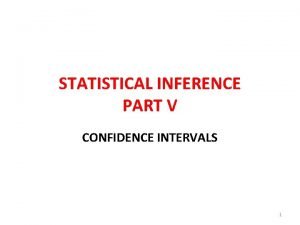Topic 5 Statistical inference point and interval estimate







































- Slides: 39

Topic 5 Statistical inference: point and interval estimate

Statistical Inference The process of making guesses about the truth from a sample. Sample statistics Truth (not observable) Sample (observation) *hat notation ^ is often used to indicate “estimate” Population parameters Make guesses about the whole population

Inferential statistics (or Statistical inference) n n Assume that we are working with the sample and we calculate a sample statistics such: sample average, sample variance, sample standard deviation. Based on the sample we assume the properties of a population. This means , the values of a sample statistics are used to estimate the unknown values of population parameters Usually we estimate parameters of population such : population mean, population variance, standard deviation of population. 3

Statistics vs. Parameters n Sample Statistic – any summary measure calculated from data; e. g. , could be a mean, n n E. g. , the mean vitamin D level in a sample of 100 men is 63 nmol/L Population parameter – the true value/true effect in the entire population of interest n E. g. , the true mean vitamin D in all middle-aged and older European men is 62 nmol/L

Graphicaly Symbols: parameters of population: , 2, , generally Q sample characteristics : Sample with size n Population – size N, resp. (infinity) Generally: un 5

What we have accomplished with sampling distributions • Given a population parameter, we know that a sample statistic will produce a better estimate of the population parameter when the sample is larger. (Better means more accurate and normally distributed). 6

Estimation: definitions • Point estimate: a single number, calculated from a set of data, that is the best guess for the parameter. • Point estimator: the equation used to produce the point estimate. • Interval estimate: a range of numbers around the point estimate within which the parameter is believed to fall. Also called a confidence interval. 7

Mathematical Theory… The Central Limit Theorem! If all possible random samples, each of size n, are taken from any population with a mean and a standard deviation , the sampling distribution of the sample means (averages) will: 1. have mean: 2. have standard deviation: 3. be approximately normally distributed regardless of the shape of the parent population (normality improves with larger n).

Symbol Check The mean of the sample means. The standard deviation of the sample means. Also called “the standard error of the mean. ”

The basics of point estimation • The typical point estimator of a population mean is a sample mean: • The typical point estimator of a population variance is a sample variance: • The typical point estimator of a population standard deviation is a sample standard deviation: 10

Typical point estimators for standard errors • Estimated standard error of samples drawn from a population: 11

Choosing a good estimator You can technically use any equation you want as a point estimator, but the most popular ones have certain desirable properties. • Unbiasedness: The sampling distribution for the estimator ‘centers’ around the parameter. (On average, the estimator gives the correct value for the parameter. ) • Efficiency: If at the sample size one unbiased estimator has a smaller sampling error than another unbiased estimator, the first one is more efficient. • Consistency: The value of the estimator gets closer to the parameter as sample size increases. Consistent estimators may be biased, but the bias must become smaller as the sample size increases if the consistency property holds true. 12

Examples for point estimates: Given the following sample of seven observations: 5, 2, 4, 5, 5 • • What is the estimator of the population mean? What is the estimate of the population mean? What is the estimator of the population standard error? What is the estimate of the population standard error for this sample? 13

Examples for point estimates: Given the following sample of seven observations: 5, 2, 4, 5, 5 • What is the estimator of the population mean? • • What is the estimate of the population mean? (5+2+4+5+5) / 7 = 28 / 7 = 4 What is the estimator of the population standard error? • o o o What is the estimate of the population standard error for this sample? =sqrt {[(5 -4)2+(2 -4)2+(4 -4)2+(5 -4)2]/(7 -1)} / sqrt(7) = sqrt { [1 + 4 + 0 + 1] / 6 } / sqrt(7) = sqrt(2) / sqrt(7) = 1. 41 / 2. 64 = 0. 53 14

Interval estimates • Interval estimate (also called a confidence interval): a range of numbers that we think has a given probability of containing a parameter. • Confidence coefficient: The probability that the interval estimate contains the parameter. Typical confidence coefficients are. 95 and. 99. 15

Interval estimate of parameter Q P(q 1 Q q 2) = 1 - q 1, q 2 – lower and upper limit of interval - random f(g) -risk of estimation (1 - ) confidence level /2 q 1 /2 q 2 16

f(u) 1 - 17

After transformation we get - sampling error - half of the interval, determinates accurancy of the estimation, Interval estimate is actually point estimate , e. g. 18

Interval estimation of population mean Confidence interval for depends on disponibility of information and sample size: a) If the variance of population is known (theoretical assumption) we can create standardized normal variables : z (u) has N(0, 1) independent on estimated value 19

b) The population variance is unknown est 2 = s 12 , and the sample size is large, n > 30 We can use N(0, 1) c) If the population variance is unknown est 2 = s 12 , and the sample size is small (less than 30), n 30 t (n-1) –critical value of Student’s distribution at alfa level and at degrees of freedom 20

Example of confidence interval. 95% confidence interval for a sample mean: example. summarize age Variable | Obs Mean Std. Dev. Min Max -------+----------------------------age | 215754 27. 34663 19. 34841 0 116. ci age Variable | Obs Mean Std. Err. [95% Conf. Interval] -------+-------------------------------age | 215754 27. 34663. 0416549 27. 26499 27. 42827 Q: how is std. err. of age calculated? 21

Equations for interval estimates. • Confidence interval of a mean • where… • and where you choose z, based on the p-value for the confidence interval you want • Assumption: the sample size is large enough that the sampling distribution is approximately normal 22

Notes on interval estimates • Usually, we are not given z. Instead we start with a desired confidence interval (e. g. , 95% confidence), and we select an appropriate z – score. • We generally use a 2 -tailed distribution in which ½ of the confidence interval is on each side of the sample mean. 23

Equations for interval estimates • Example: find c. i. when Ybar =10. 2, s=10. 1, N=1055, interval=95%. • z is derived from the 95% value: what value of z leaves 95% in the middle and 2. 5 % on each end of a distribution? • For p =. 975, z = 1. 96 • The standard error is s/SQRT(n) = 10. 1/SQRT(1055) =. 31095 • Top of the confidence interval is 10. 2 + 1. 96*. 31095 = 10. 8095 • The bottom of the interval is 10. 2 – 1. 96*. 31095 = 9. 5905 • Hence, the confidence interval is 9. 59 to 10. 81 24

Confidence Intervals The value of the statistic in my sample (eg. , mean, odds ratio, etc. ) point estimate (measure of how confident we want to be) (standard error) From a Z table or a T table, depending on the sampling distribution of the statistic. Standard error of the statistic.

Common “Z” levels of confidence n Commonly used confidence levels are 90%, 95%, and 99% Confidence Level 80% 95% 98% 99. 9% Z value 1. 28 1. 645 1. 96 2. 33 2. 58 3. 08 3. 27

Confidence Interval on the Variance and Standard Deviation of a Normal Distribution

Summary Statistics for Business and Economics, 6 e © 2007 Pearson Education, Inc. Chap 4 -28

Important notes regarding confidence intervals n n The width of the confidence interval is related to the significance level, standard error, and n (number of observations) such that the following are true: the higher the percentage of accuracy (significance) desired, the wider the confidence interval the larger the standard error, the wider the confidence interval the larger the n, the smaller the standard error, and so the narrower the confidence interval Statistics for Business and Economics Chap 4 -29

Important note regarding the sample size and sampling error n n n The lower the desired sampling error the larger the sample size must be. Note: Sampling error is influenced by: confidence level - we can influence the confidence level (sample) standard deviation - we can't influence the variability within the sample (chosen from the collected set of data) sample size - we can influence the sample size Statistics for Business and Economics Chap 4 -30

Point estimate of mean n Statistics for Business and Economics Chap 4 -31

Interval estimate of mean n Statistics for Business and Economics Chap 4 -32

Interval estimate of mean n Statistics for Business and Economics Chap 4 -33

Point estimate of variance n Statistics for Business and Economics Chap 4 -34

Interval estimate of variance Statistics for Business and Economics Chap 4 -35

Point estimate of standard deviation n Statistics for Business and Economics Chap 4 -36

Interval estimate of standard deviation n Statistics for Business and Economics Chap 4 -37

Calculating the sample size n Statistics for Business and Economics Chap 4 -38

Next topic n Hypothesis testing Thank you! Have a nice day!
 Point estimate equation
Point estimate equation Proof of chebyshev's inequality
Proof of chebyshev's inequality Probability and statistical inference 9th solution pdf
Probability and statistical inference 9th solution pdf Statistical inference
Statistical inference Statistical inference is concerned with
Statistical inference is concerned with Statistical inference is divided into
Statistical inference is divided into Interval diperlukan dalam penciptaan musik interval adalah
Interval diperlukan dalam penciptaan musik interval adalah Primary reinforcer
Primary reinforcer Variable interval
Variable interval Clueing topic sentence
Clueing topic sentence Narrow down the topic
Narrow down the topic Wecan95
Wecan95 Section
Section How to find point estimate
How to find point estimate How to find point estimate
How to find point estimate What is a point estimate in statistics
What is a point estimate in statistics What is the point estimate of μ?
What is the point estimate of μ? Point estimate
Point estimate What is the point estimate of μ?
What is the point estimate of μ? How to calculate point estimate
How to calculate point estimate Contoh soal estimasi titik dan interval
Contoh soal estimasi titik dan interval T interval
T interval Standard error of regression
Standard error of regression Single point estimate
Single point estimate Single point estimate
Single point estimate Population mean
Population mean Wvu stat 211
Wvu stat 211 Likert scale of attitude measurement
Likert scale of attitude measurement Hub and spoke airline
Hub and spoke airline Point proof discussion
Point proof discussion Hindi presentation topics
Hindi presentation topics Estimate and rounding
Estimate and rounding Estimate fraction sums and differences
Estimate fraction sums and differences Excavation is measured in
Excavation is measured in Estimate powers and roots
Estimate powers and roots What is front end rounding with decimals
What is front end rounding with decimals Extrema and average rates of change
Extrema and average rates of change Estimate and classify the extrema for the graph
Estimate and classify the extrema for the graph Round the factors and estimate the products 656 x 106
Round the factors and estimate the products 656 x 106 Round the factors and estimate the products 656 x 106
Round the factors and estimate the products 656 x 106
